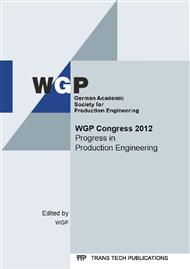[1]
Kendall DP (2000) A Short History of High Pressure Technology from Bridgman to Division 3. Journal of Pressure Vessel Technology 122: 229-233.
DOI: 10.1115/1.556178
Google Scholar
[2]
Klocke F, König W (2007) Fertigungsverfahren 3 – Abtragen, Generieren und Lasermaterialbearbeitung. 4th edn., Springer Verlag Berlin Heidelberg.
Google Scholar
[3]
Gruden D (2008) Umweltauswirkungen des Dieselmotors. In: Umweltschutz in der Automobilindustrie. Vieweg + Teubner Verlag Wiesbaden.
DOI: 10.1007/978-3-8348-9526-4_5
Google Scholar
[4]
Seeger T, Greuling S, et al (2001) Autofrettage II – Dauerfestigkeitssteigerung durch Autofrettage II. Forschungsvereinigung Verbrennungskraftmaschinen, Vorhaben Nr. 671.
Google Scholar
[5]
Diemar A, Linne K, et al. (2003) Einsatzhärten und Autofrettage – Dauerfestigkeitssteigerung einsatzgehärteter Hochdruckbauteile durch Autofrettage. Forschungsvereinigung Verbrennungskraftmaschinen, Vorhaben Nr. 784.
Google Scholar
[6]
Brinksmeier E, Cammett JT et al (1982) Residual Stresses - Measurement and Causes in Machining Processes. Annals of the CIRP 31/2: 491-510.
DOI: 10.1016/s0007-8506(07)60172-3
Google Scholar
[7]
Bähre D, Brünnet H (2011) Simulation of Removing Autofrettage-induced Residual Stress Loaded Layers by Finite Element Analysis. Procedia Engineering 19: 9-15.
DOI: 10.1016/j.proeng.2011.11.072
Google Scholar
[8]
Brünnet H, Yi I, Bähre D (2011) Modeling of Residual Stresses and Shape Deviations along the Process Chain of Autofrettaged Components. Journal of Materials Science and Engineering A 1/7: 915-936.
DOI: 10.4028/www.scientific.net/msf.768-769.79
Google Scholar
[9]
Gibson MC (2008) Determination of Residual Stress Distributions in Autofrettaged Thick-Walled Cylinders. Dissertation, Cranfield University.
Google Scholar
[10]
Lechmann, M (2007) Entwicklung eines schwingbruchmechanischen Auslegungskonzeptes für innendruckbeanspruchte Bauteile mit ausgeprägten Druckeigenspannungsfeldern. Dissertation, Universität Stuttgart.
Google Scholar
[11]
Mischorr G (1990) Zur Ermüdung dickwandiger Rohre aus weichmartensitischen und halbaustenitischen Chrom-Nickel-Stählen durch schwellenden Innendruck. Dissertation, Universität Erlangen-Nürnberg.
Google Scholar
[12]
Seeger T, Schön M et al (1994) Autofrettage I – Dauerfestigkeitssteigerung durch Autofrettage. Forschungsvereinigung Verbrennungskraftmaschinen, Vorhaben Nr. 478.
Google Scholar
[13]
Löhe D, Lang KH, et al (2002) Residual Stresses and Fatigue Behavior. Handbook of Residual Stress and Deformation of Steel, ASM International, Materials Park, Ohio.
Google Scholar
[14]
Parker AP, Troiano E, et al (2003) Characterization of Steels Using a Revised Kinematic Hardening Model Incorporating Bauschinger Effect. J. of Pressure Vessel Technology 125: 277-281.
DOI: 10.1115/1.1593071
Google Scholar
[15]
Jahed H, Ghanbari G (2003) Actual Unloading Behavior and Its Significance on Residual Stress in Machined Autofrettaged Tubes. J. Pressure Vessel Technolog 125/3: 321-325.
DOI: 10.1115/1.1593070
Google Scholar
[16]
Huang XP (2005) A General Autofrettage Model of a Thick-walled Cylinder based on Tensile-compressive Stress-strain Curve of a Material. J. Strain Analysis 40/6: 599-607.
DOI: 10.1243/030932405x16070
Google Scholar
[17]
Macherauch E (1987) Praktikum in Werkstoffkunde. Vieweg Verlag.
Google Scholar
[18]
Bauschinger J (1886) Über die Veränderung der Elastizitätsgrenze und der Festigkeit des Eisens und Stahls durch Strecken und Quetschen, durch Erwärmen und Abkühlen und durch oftmals wiederholte Beanspruchung. Mitt. Mech. -Techn. lab. K. TH München 13: 266-274.
DOI: 10.1007/978-3-662-40295-5_1
Google Scholar
[19]
Zhu R, Yang Y (1998) Autofrettage of thick cylinders. International Journal of Pressure Vessels and Piping 75: 443-446.
DOI: 10.1016/s0308-0161(98)00030-1
Google Scholar
[20]
Ayob A, Elbasheer MK (2007) Optimum Autofrettage Pressure in Thick Cylinders. Jurnal Mekanikal 24: 1-14.
Google Scholar
[21]
Schön M (1995) Eigenspannungs- und Dauerfestigkeitsberechnung autofrettierter innendruckbeanspruchter Bauteile. Dissertation, TH Darmstadt.
DOI: 10.1002/mawe.19950260706
Google Scholar
[22]
Hojjati MH, Hassani A (2007) Theoretical and finite-element modeling of autofrettage process in strain-hardening thick-walled cylinders. International Journal of Pressure Vessels and Piping 84: 310-319.
DOI: 10.1016/j.ijpvp.2006.10.004
Google Scholar
[23]
Greuling S, Bergmann JW, Thumser R (2001) Ein Konzept zur Dauerfestigkeitssteigerung autofrettierter Bauteile unter Innendruck. Mat. -wiss. U. Werkstofftech. 32: 342-352.
DOI: 10.1002/1521-4052(200104)32:4<342::aid-mawe342>3.0.co;2-7
Google Scholar
[24]
Leutwein U (2008) Einfluss von Autofrettage auf die Schwingfestigkeit innendruck-belasteter Bauteile aus Kugelgraphitguss. Dissertation, TU Illmenau.
Google Scholar
[25]
Läpple V (2008) Einführung in die Festigkeitslehre. 2nd edn, Vieweg + Teubner Verlag, Wiesbaden.
Google Scholar
[26]
Reynolds C, Kandlikar M (2007) How hybrid-electric vehicles are different from conventional vehicles: the effect of weight and power on fuel consumption. Environ. Res. Lett. 2: 014003.
DOI: 10.1088/1748-9326/2/1/014003
Google Scholar


